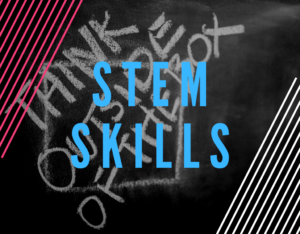With the rise of STEM education in recent years, the comparison between STEM vs. liberal arts has come into play. A combination of having taken both types of classes plus my knowledge-seeking nature as a librarian has prompted me to tackle this question head-on.
STEM vs. liberal arts: how do they compare? STEM and the liberal arts both are a part of each other and complement each other. Science and math are liberal arts, while humanities complement science, technology, engineering, and math.
While some majors are clear cut, others can fall into both categories. Take graphic design for example. Computer software and hardware are needed to create digital graphics. An understanding of art elements, such as its history and color combinations, are also essential. We cannot merely compare STEM vs. liberal arts unless we understand where each field falls.
Table of Contents
List of STEM Majors
- Actuarial Science
- Aeronautical/Aerospace Engineering Technology
- Aerospace/Aeronautical Engineering
- Agricultural/Bioengineering
- Agronomy and Crop Science
- Animal Sciences
- Applied Mathematics
- Architectural Drafting/CAD Technology
- Architectural Engineering
- Architectural Engineering Technology
- Architecture, General
- Astronomy
- Athletic Training
- Atmospheric Sciences and Meteorology
- Automotive Engineering Technology
- Biochemistry and Biophysics
- Biology, General
- Biomedical Engineering
- Business/Management Quantitative Methods, General
- Cell/Cellular Biology
- Chemical Engineering
- Chemistry
- Chiropractic (Pre-Chiropractic)
- Civil Engineering
- Civil Engineering Technology
- Computer and Information Sciences, General
- Computer Engineering
- Computer Engineering Technology
- Computer Network/Telecommunications
- Computer Science and Programming
- Computer Software and Media Application
- Computer System Administration
- Construction Engineering/Management
- Construction/Building Technology
- Data Management Technology
- Dentistry (Pre-Dentistry)
- Drafting/CAD Technology, General
- Ecology
- Electrical, Electronic, and Communication Engineering
- Electrical/Electronics Engineering Technology
- Electromechanical/Biomedical Engineering Technology
- Emergency Medical Technology
- Engineering (Pre-Engineering), General
- Engineering Technology, General
- Environmental Control Technologies
- Environmental Health Engineering
- Environmental Science
- Food and Nutrition
- Food Sciences and Technology
- Forestry
- Genetics
- Geological and Earth Sciences
- Health/Medical Technology, General
- Horticulture Science
- Industrial Engineering
- Industrial Production Technologies
- Information Science
- Management Information Systems
- Marine/Aquatic Biology
- Mathematics Education
- Mathematics, General
- Mechanical Drafting/CAD Technology
- Mechanical Engineering
- Mechanical Engineering Technology
- Medical Laboratory Technology
- Medical Radiologic Technology
- Medicine (Pre-Medicine)
- Microbiology and Immunology
- Military Technologies
- Natural Resources Conservation, General
- Natural Resources Management
- Nuclear Engineering
- Nuclear Medicine Technology
- Nursing, Practical/Vocational (LPN)
- Nursing, Registered (BS/RN)
- Optometry (Pre-Optometry)
- Osteopathic Medicine
- Pharmacy (Pre-Pharmacy)
- Physical Sciences, General
- Physical Therapy (Pre-Physical Therapy)
- Physician Assisting
- Physics
- Quality Control and Safety Technologies
- Respiratory Therapy Technology
- Science Education
- Statistics
- Surgical Technology
- Surveying Technology
- Veterinarian Assisting/Technology
- Veterinary Medicine (Pre-Vet)
- Webpage Design
- Wildlife and Wildlands Management
- Zoology
List of Liberal Arts Majors
This would be a very long list, so I decided to list a bunch that aren’t limited to:
- Accelerated Culinary Arts
- Accountancy
- Accounting and Information Systems
- Accounting Specialist
- Actuarial
- Administration of Justice
- Administrative Support
- Advanced Study
- Advertising
- Agribusiness
- Agriculture
- American Indian Studies
- American Studies
- Engineering and Biotechnology
- Animal Management
- Anthropology
- Applied Cognition and Neuroscience
- Applied Finance
- Applied Mathematical Sciences
- Applied Psychology
- Applied Science
- Architectural Building Engineering Technology
- Architecture
- Architecture and Career Options
- Archives and Records Management
- Art
- Arts
- Athletic Training
- Aviation Mechanics
- Baking and Pastry
- Behavioral Science
- Bible
- Bioethics
- Bioinformatics
- Biology
- Biomedical Science
- Biotechnology
- Boat Mechanics
- Boat Repair and Maintenance
- Business
- Business Administration
- Business Administration – Finance
- Business Administration Clinical Science
- Business Analytics
- Business Economics
- Business Informatics
- Business Information Systems
- Business Science (ABS) Individualized Studies
- Chemistry
- Child Advocacy
- Child Development: Program Summary
- Christian Ministry
- City Planning
- Civil Justice – Law Enforcement
- Clinical Epidemiology
- Clinical Laboratory Science
- Clinical Medical Assisting
- Clinical Psychology
- Cognitive Science
- Commerce
- Communication
- Community Health
- Composition
- Computational Finance
- Construction Management
- Corrections, Probation, & Parole
- Cosmetology Business
- Counselling (or Counseling)
- Criminal Justice
- Criminology
- Culinary Arts
- Design
- Development Administration
- Diagnostic Radiography
- Digital Media
- Digital Media Communications
- Digital Photography
- Divinity
- Early Childhood Education (AECE)
- Early Childhood Special Education
- Economics
- Education
- Elementary Education
- Emergency Medical Services
- English
- English Literature
- Enterprise
- Environmental Science
- Environmental Studies
- European Law
- Finance
- Financial Economics
- Financial Mathematics
- Fine Arts
- Food Science
- Foreign Service
- Forensic Psychology
- Forensic Science
- Forestry
- General Psychology
- Governance & Organizational Sciences
- Government Contracts
- Health Administration
- Health Care Management
- Health Informatics
- Health Information Management
- Health Science
- Healthcare Administration
- History
- History and Information
- Hospitality Management
- Human Resource Development
- Human Resources Management
- Humanities
- Industrial and Labor Relations
- Information
- Information Assurance
- Information Management
- Information System Management
- Information Systems
- Information Technology
- Integrated Science
- Interactive & Graphic Art
- Interdisciplinary Studies
- Interior Architecture and Design
- International Affairs
- International Business
- International Economics
- International Public Policy
- International Relations
- International Studies
- Islamic Studies
- Jazz Studies
- Journalism
- Jurisprudence
- Landscape Architecture
- Landscaping Design
- Laws
- Leadership
- Legal Management
- Letters
- Liberal Arts
- Liberal Studies
- Library and Information Science
- Library Science
- Management
- Manufacturing Engineering
- Marketing
- Mass Communication and Journalism
- Mathematical Finance
- Mathematics
- Mathematics and Computer Science
- Mathematics and Philosophy
- Medical Science
- Medicine
- Meteorology
- Microbiology
- Military Art and Science
- Molecular Biology
- Museum Studies
- Music
- Music Education
- Network and Communications Management
- Neuroscience
- Nursing
- Nutrition science
- Occupational Studies (AOS) Legal Office Administration
- Occupational Therapy
- Organizational Psychology
- Performance
- Petroleum Engineering
- Pharmacology
- Pharmacy
- Philosophy
- Physical Therapy
- Physician Assistant Studies
- Physics
- Physiology
- Plant Science
- Podiatry
- Political Science
- Politics
- Professional Studies
- Project Management
- Psychology
- Public Administration
- Public Affairs
- Public Diplomacy
- Public Health
- Public Management
- Public Policy
- Public Relations
- Public Safety
- Public Service
- Quality Assurance
- Quantitative Finance
- Quantity Surveying Engineering
- Rabbinic Studies
- Radiologic Technology
- Real Estate Development
- Real-Time Interactive Simulation
- Religion
- Religious Education
- Research
- Respiratory Therapy
- Risk Management
- Risk Management and Insurance
- Sacred Music
- Sacred Theology
- Science
- Science Education
- Social Science
- Social Work
- Sports Management
- Statistics
- Strategic Communication Management
- Strategic Studies
- Studies
- Studies Law
- Supply Chain Management
- Surgery
- Taxation
- Teaching
- Teaching Athletic Training
- Telecommunications Technology
- Television Production
- Theological Studies
- Theology
- Theory
- Urban Planning
- Veterinary Science
- Veterinary Technology
- Visual Communications
- Wildlife Management
The Difference
If you take a look at both lists, you’ll notice that some STEM majors are also liberal arts majors. That’s because science and math are liberal arts fields as well. This means that it’s not entirely possible to compare STEM vs. liberal arts.
STEM often focuses on specific outcomes or products. STEM degree students usually have higher starting and mid-career salaries than liberal arts majors because of a high technical career demand.
Liberal arts can set students up for success in the future. They usually focus on careers that focus on people. Examples of this include public service, humanities, and teaching.
Are STEM Majors Better than Liberal Arts Majors?
It’s easy to think that STEM majors are better than liberal arts majors because of all the hype around STEM lately. STEM has started to integrate into elementary schools through after-school programs and some curriculums. Libraries have STEM stations and makerspaces and programs directed towards STEM. Many toys these days even say they are “STEM Aligned.”
Taking cues from what’s popular isn’t always such a good idea.
STEM programs have been receiving grants and earmarks because of its subject’s direct correlation to the career fields that need attention. While STEM does need the attention and resources to grow, to create a complete, well-rounded STEM program, liberal arts is crucial. While doing so, liberal arts programs will receive some well-deserved attention to stay relevant.
Now, if you want to separate STEM from the liberal arts, then that would be a different story. This means that science and mathematics would be taken out of liberal arts and what would be left is a bit more than the humanities, which include the arts (performing arts, fine arts, music, literature), religious studies, and philosophy.
While this may be the wrong path, the opposite (combining STEM entirely with liberal arts) would be better for a couple of reasons.
In a previous post, I discussed how STEM education could shape the future. To help keep the U.S. stay competitive on the world stage, we need a STEM-skilled workforce that will fill the number of jobs the future holds. To keep up with the times, liberal arts needs to incorporate STEM.
But, liberal arts isn’t a wounded leg needing STEM crutches. Liberal arts has been the focal point of higher education for centuries. It has created the foundation for the advancement of science, technology, engineering, and math.
STEM Needs Liberal Arts as Much as Liberal Arts Needs STEM
It’s like a well-balanced meal or a peanut butter and jelly sandwich. Many leaders of institutions see STEM vs. liberal arts as a false debate. They are best used to complement each other.
Art has been added to STEM to create STEAM for a good reason. The processes of the STEM disciplines naturally work together. The scientific method is used to develop mathematically analyzed data for engineers to create new technology that solves a problem using existing technology. The process of art, when it is seen as the creation of appreciated beauty and emotional power, has little to do with science, technology, engineering, or math, but it can help.
Look at Leonardo Da Vinci, for example. He is known for being ahead of his time. His knowledge in mathematics, technology, and engineering has led him to create art masterpieces such as The Last Supper and the Vitruvian Man. His creative imagination has led him to develop concepts in the late 1400s that are seen today, such as helicopters, diving suits, and parachutes.
Some colleges and universities have started to emphasize STEM fields in their liberal arts programs. Wesleyan University, Smith College, Lafayette College, and Swarthmore College are among several institutions that have begun to highlighted science, technology, engineering, and math.
The reverse is true for STEM-focused universities. Technology and engineering-focused institutions are trying to introduce the liberal arts model into their curriculum. For example, students at the Rochester Institute of Technology (RIT) must complete a technology-infused general education curriculum.
It is important to study implications outside of STEM as much as it is to study inside it. For example, artificial intelligence technology has brought up economic, philosophical, and ethical implications. Liberal arts is needed to focus on questions about online privacy and political censorship. No matter what field it is, no work gets done in a private bubble, and liberal arts is adequately equipped for open discussion.
Over the years, liberal arts has had some significant supporters. Thomas Jefferson placed high importance on education, saying “informed” people can protect their own freedom. He believed that general studies supported democracy because it makes citizens more thoughtful.
So, it would be unwise to take STEM out of the liberal arts. Setting them apart weakens a tolerant society. It also contradicts the intent of universities as a place where a range of discovery and learning is linked together.
Is Liberal Arts A Good Major?
I see many parents and students not sure if a major will lead to a job that pays well. It is fashionable to assume that the liberal arts aren’t as good as technical or professional majors. After all, science, engineering, and pre-professional graduates do earn more from the start.
But this doubt should not exist because over time, that advantage decreases and there is a lot of credible data showing liberal arts majors doing great in a significant scope of industries. For example, a report released by the Andrew Mellon Foundation called “The Economic Benefits and Costs of a Liberal Arts Education” has proven that those inclined towards the arts and humanities can succeed financially. George Andres wrote an article for The Atlantic, called “The Unexpected Value of the Liberal Arts,” where he exposes students who have found professional fulfillment in the humanities and social sciences. In 2014, Debra Humphreys and Patrick Kelly released the report, “How Liberal Arts and Science Majors Far in Employment,” that shows how general education prepares students for professional and financial success.
Ignoring the importance of the liberal arts doesn’t make sense socially or economically. The liberal arts not only pay well, but they are also the foundations of our society. We should be proud of it and protect it.
With all the data showing that liberal arts majors doing well in the job market, many parents and students still believe it’s risky to take on liberal arts fields. This means that we must focus the discussion on the fact that STEM vs. liberal arts is not a competition. Liberal arts gives STEM the humane touch that a civil society needs to flourish.
Conclusion
There used to be a time when having any type of degree gave you a considerable advantage over the rest, highlighting your intellect and opening up a world of opportunities. These days, the saturated graduate market has made those having a degree less distinguishable from non-graduates.
Bill Gates once criticized public universities by saying that states are wasting taxpayers’ money by subsidizing programs that do not help shape the future. It is essential to know that colleges are businesses. There are for-profit colleges that stay in operation solely through grants and student loans. Yes, they do have a necessary role in further education but colleges and universities also exist to make money. Of course, not all colleges have the same ratio of being profit-hungry and wanting to lead students to a lucrative career. It is up to the aspiring college student to do their research in finding that.
Related Question
What Can I Do With A Liberal Arts Degree?
Many colleges offer an associate (2-year) degree for liberal arts, which is excellent if you are unsure of what you want to pursue a bachelor’s degree eventually. A liberal arts associate degree program will allow you to discover different fields while gaining credits for the one you ultimately choose to pursue.



